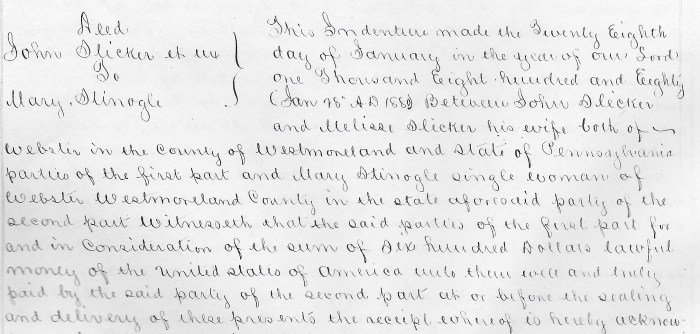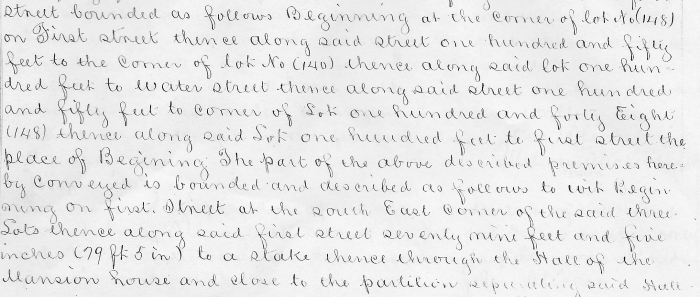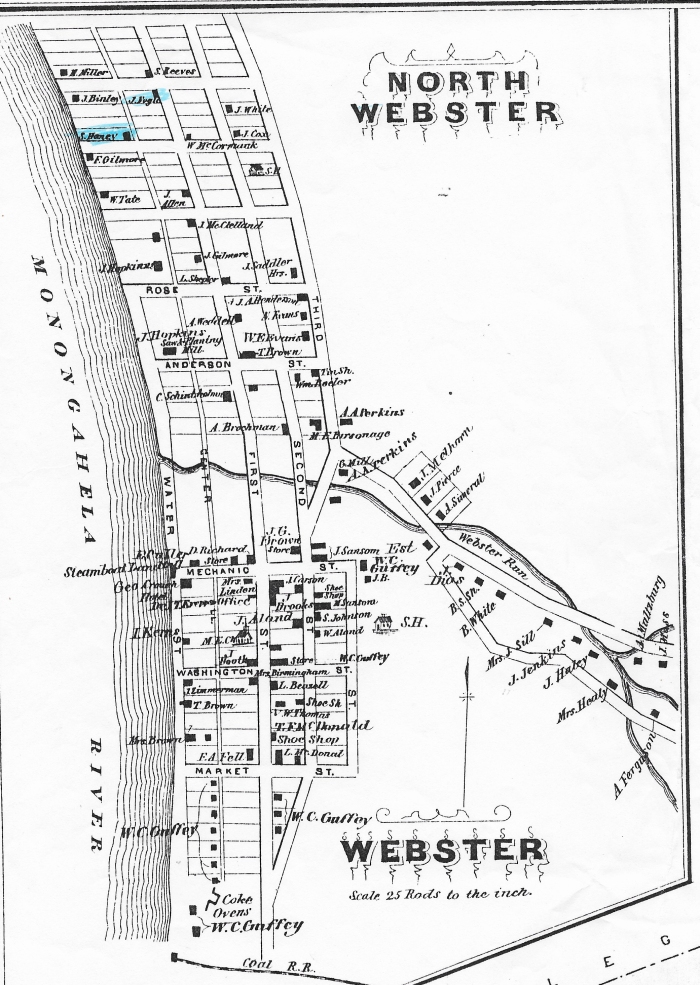This is part two of a two-part series narrating the history of John Slicker’s life. Part one of this series The Life of John Slicker (1857-1929) – Part 1 gives a brief narrative of John’s life from 1857, the year he was born, until 1890. This second part highlights events in John’s life from 1890 until 1929, the year he died. As you read part two, you may notice that I have not documented the sale of the property John and Malissa owned in Conemaugh Township, Indiana County, Pennsylvania. I’m not certain if I had a copy of that property deed and misplaced it; or I just didn’t look for it when I was at the Indiana County Courthouse. Nonetheless, I hope to find it. If I do, I will be updating this post to include the sale of that property. So, if you are interested in knowing about that sale, you may want to check back in a month or two.
August 30th, 1890 Malissa signed a property deed agreeing to pay three hundred and fifty dollars for two lots in Apollo Borough.[1] Five years and two months later – on November 5th, 1895- John and Malissa sold their two lots in Apollo for one thousand dollars.[2] They moved the family to Conemaugh Township, Indiana County, Pennsylvania. On December 10th of the same year, Malissa purchased eight acres and forty and six-tenths perches. Malissa agreed to pay four hundred dollars for this plot of land.[3] It is here, John and Malissa’s sixth son, William Eugene, was born December 13th, 1896.[4]
January 7th, 1892 John’s mother, Magdlena, passed away. John and Malissa were still living in Apollo. Although I have not found any written record, it is probable that John returned to Webster to attend the funeral service. Malissa who had just given birth three weeks earlier to their sixth child most likely didn’t make the trip, but rather stayed home to tend to the newborn and the other Slicker children.
The year was 1900. Twenty years had passed since John and Malissa were united in marriage. During these twenty years they had moved from Webster, Westmoreland County, Pennsylvania to Apollo, Armstrong County to Conemaugh Township in Indiana County. Over the years John went from digging coal in the mines of Webster to working as a catcher in a rolling mill. His eldest son, Frank, now seventeen, joined his father in the rolling mill as a matcher. Malissa with help from son, Samuel, age 15, was farming the eight acres of land she and John owned. It seemed the family worked together to make life better, but it wasn’t easy. Both John and Frank had been unemployed eight months between June 1st, 1899 to June 1st, 1900. Although Malissa purchased the eight acres in 1895, they were still carrying a mortgage.[5]
The year was 1910. By 1910 Frank, Samuel, and Ruth had married and left home. Frank, Samuel, George, James and Ruth’s husband were working at the sheet iron mill. John Slicker had left the mills and turned to farming the land. Malissa and the younger two children were probably helping with the farm work. In the years following 1901, John and Malissa had welcomed young Fred Manners into their home. Fred was listed as an adopted son in the 1910 United States census. John and Malissa were still carrying a mortgage on their property.[6]
The year was 1914. On October 23rd, 1914 John and Melissa agreed to pay three hundred dollars for lots eighteen and nineteen in Washington Township, Westmoreland County, Pennsylvania. Each lot had frontage of forty feet on a public street then called Brick Road. The lots extended one hundred twenty feet from Brick Road to an alley.[7] Those two lots would become Malissa and John’s last purchased property.
The year was 1917. On February 23rd, Eva Stinogle Vogel, John’s eldest half-sister passed away.[8] She was seventy years old. It is unknown whether John returned to Webster for the funeral service. Eva is buried next to her mother at St. Mary’s Cemetery in Monongahela, Pennsylvania.
The year was 1920. It was the start of the Roaring Twenties. The coming decade of economic prosperity and political and cultural change began with women being granted the right to vote, and the enactment of the Volstead Act which closed every bar, tavern and saloon in the United States marking the era of Prohibition. A greater part of the population lived in the cities and small towns than on farms. An increasing number of women were entering the work force. Many American families had extra money to spend; and they spent it on consumer goods – electric washing machines, refrigerators, and vacuum cleaners, radios, ready-to wear clothes, and automobiles.
Despite the major political and cultural changes taking place in America, one cultural norm remained almost intact – families living close to one another. And thus, we find John and Malissa Slicker living on Brick Road, Washington Township (now present-day borough of Oklahoma), Westmoreland County; nearby and on the same road, we find John and Ruth Slicker Hardwick and their four children, Albert and Matilda Slicker Seighman and their three children, George M. And Bessie E. Slicker and their two children, and Samuel and Ethel Hardwick Slicker and their five children and Ethel’s mother, Violet Hardwick. John and Malissa’s son, Frank is living with his wife, Estella, and their five children across the river in the borough of Apollo.
At the time of this writing, I have been unsuccessful in locating James C. and William Eugene in the 1920 census. William’s wife, Lela, and their six-month old son, Eugene, are living with Lela’s parents on the west side of Warren Avenue in Apollo.
All the Slicker men, except John, were working in a steel mill. John was a general merchant and owned his own shop. His adopted son, Fred R. Manners was still living with John and Malissa. Fred was seventeen and working as a utility boy for the railroad.[9]
The year was 1921. John must have received the news from his half-sister, Mary, about the passing of his half-brother, Conrad Stinogle. Conrad, a retired coalminer, left this earth on May 22, 1921.[10] He is buried in the Monongahela City Cemetery, in Monongahela, Pennsylvania.
The year was 1924. Mary, John’s half-sister, sold the property she had purchased from John and Malissa in 1880.[11] In 1930 Mary and her two sons, Samuel and James, moved to Butler, Hancock County, West Virginia. Twelve years later Mary, who was living with her son, James in Holidays Cove, Hancock County, West Virginia, passed away.[12]
The year was 1929. On July 31st, about three months before the Roaring Twenties were to come to a crashing halt, John Slicker, our ancestor, left his earthly journey.[13] The second generation of this branch of the Slicker family tree was laid to rest in the Vandergrift Cemetery, in Vandergrift, Pennsylvania. Malissa would join John twenty-nine years later.
You can visit John’s and Malissa’s Find-A-Grave memorials at:
John Slicker’s Memorial Page at Find-A-Grave
If you know additional details or have a story about John Slicker’s life and would like to share, please do so in the comment section below.
References:
[1] Armstrong County, Pennsylvania, Deed Book 75:75, S.M. Jackson to Melissa Slicker, 13 August 1890; Recorder of Deeds Office, Kittanning.
[2] Armstrong County, Pennsylvania, Deed Book 84:196, John Slicker to Esther Owens, 4, November 1895; Recorder of Deeds Office, Kittanning.
[3] Indiana County, Pennsylvania, Deed Book 6976:296, Julia A. Hartlett to Malissa J. Slicker, 10 December 1895; Recorder of Deeds Office, Indiana.
[4] “1900 United States Federal Census,” Ancestry.com, (http://www.ancestry.com : accessed 25, July 2017), entry for William E. Slicker (age 3), Conemaugh Township, Indiana County, Pennsylvania.
[5] “1900 United States Federal Census,” Ancestry.com, (http://www.ancestry.com : accessed 25, July 2017), entry for John Slicker Family (9 members), Conemaugh Township, Indiana County, Pennsylvania.
[6] “1910 United States Federal Census,” Ancestry.com, (http://www.ancestry.com : accessed 25, July 2017), entry for John Slicker Family (7 members), Conemaugh Township, Indiana County, Pennsylvania.
[7] Westmoreland County, Pennsylvania, Deed Book 554:137, John Orr Chambers to John Slicker, 23 October 1914; Recorder of Deeds Office, Greensburg
[8] Pennsylvania Department of Health, death certificate 25302 (1917), Eva Vogel, Division of Vital Records, New Castle.
[9] “1920 United States Federal Census,” Ancestry.com, (http://www.ancestry.com : accessed 25, July 2017), entry for John Slicker Family (3 members), Washington Township, Westmoreland County, Pennsylvania.
[10] Pennsylvania Department of Health, death certificate 49167 (1921), Conrad Stinogle, Division of Vital Records, New Castle.
[11] Westmoreland County, Pennsylvania, Deed Book 791:59, Mary Sharrow to Paul Tomecko ET UX, 3 September 1924; Recorder of Deeds Office, Greensburg
[12] West Virginia State Department of Health, death certificate 7484 (1942), Mary Sharrow, Division of Vital Records, New Castle.
[13] Pennsylvania Department of Health, death certificate 77663 (1929), John Slicker, Division of Vital Records, New Castle.
© Robin Slicker, 2017. All Rights Reserve.






